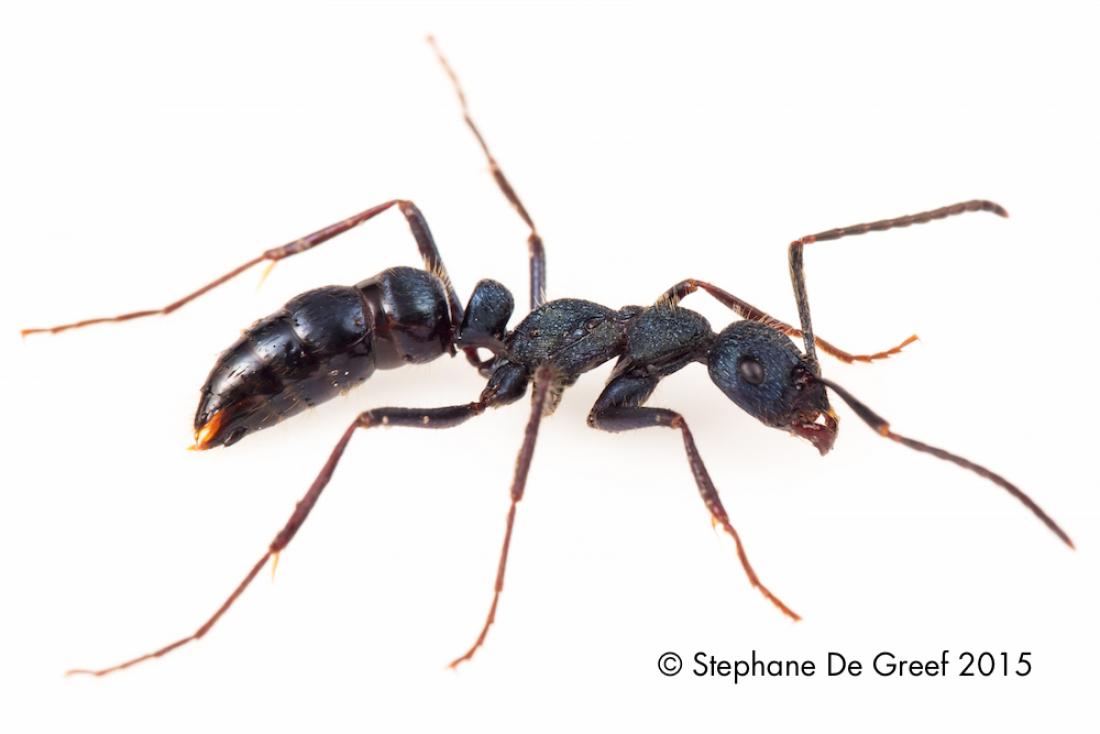A closer look at this undescribed species of Leptogenys , showing its blue hue and the gastral constriction that plays a crucial role in the chain formation.
In 2010, ant researchers Christian Peeters and Stéphane De Greef spotted chains of bluish ants dragging a huge millipede in Phnom Kulen National Park, Cambodia. Each ant bit on a constriction on the abdomen of the ant ahead of it, while the first ant bit tight on the millipede's antenna. Walking backwards, the ants heaved the millipede away.
Those ants belong to the genus Leptogenys. Dr Peeters, an expert in animal communications and evolutionary biology at the French National Centre for Scientific Research, knew the behaviour was unique.
Other ants form chains too. Weaver ants and army ants build chains to sew nests and cross waters respectively. But the bluish Leptogenys sp. ants are the first insects documented to move prey by making chains.
In 2014, Peeters and De Greef, an environmental engineer based in Cambodia who researches ants as a hobby, decided to better study the ants. They observed three Leptogenys colonies in Cambodia and published their findings in Insectes Sociaux in August 2015.
Peeters and De Greef observed that a Leptogenys sp. raid starts with one of its 14mm-long ants touching a 150mm-long, coiled-up millipede with its antennae. It then backs off slightly, facing the millipede, while the other ants encircle the millipede without attacking, demonstrating great restraint that suggests specialized adaptation. When the millipede uncoils, an ant bites its leg and the millipede snaps into a frenzy. Then all ants lunge forth, stinging the soft gaps between the millipede's legs. The millipede twists violently, hurling some ants off until, minutes later, it stops, probably paralysed by the ants’ stings.
Now the ants move their hefty prize, dragging the millipede's legs and antennae. Chains form – linear, parallel, even branched – and the longest chain pulls the antennae. Some ants walk ahead of the chains, presumably laying down chemical trails or clearing the path.
Although Leptogenys ants and millipedes coexist on other continents, self-assembling chains seem limited to South-East Asia.
The ant is a new species and is most closely related to Leptogenys chalybaea, another blue-metallic ant in Borneo, according to Koichi Arimoto, who studies Leptogenys ants at Kyushu University in Japan. Koichi is writing a paper to describe and name the ant. Although this new Leptogenys species appears to be distributed across Cambodia, Thailand and Vietnam, Koichi says that each population may be a different species.
For further information contact:
Professor Christian Peeters
Institute of Ecology and Environmental Sciences
Université Pierre et Marie Curie, Paris, France
E-mail: [email protected]
Mr Stéphane De Greef
24 avenue de Genéral De Gaulle, 17252 Siem Reap, Cambodia
E-mail: [email protected]



